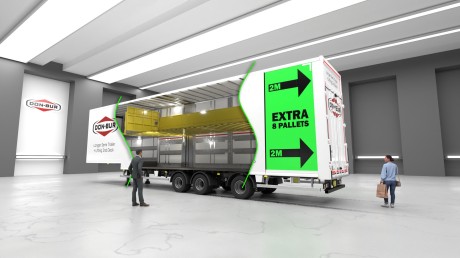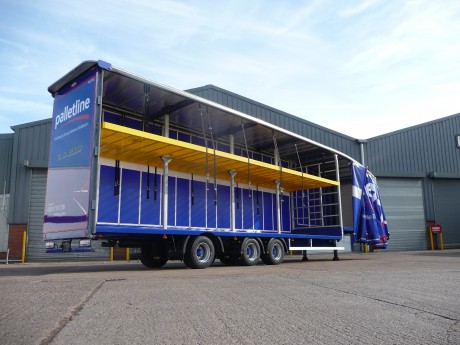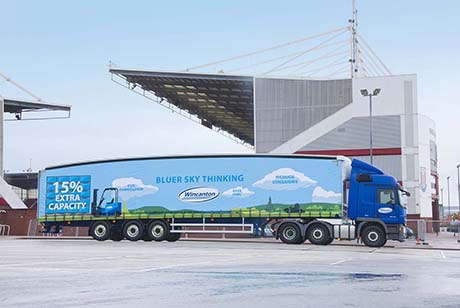As delivery environments become tighter and trailer lengths increase, the importance of steering axles has never been greater. Whether operating a full-length Longer Semi-Trailer (LST) or a compact urban trailer, steering axles can significantly improve vehicle handling, reduce tyre wear, and minimise road surface damage.
There are three main types of trailer steering systems commonly used across the industry: self-steer, positive steer, and command steer.
Self-Steer Axles
Self-steer axles are the most affordable steering option. They rely on free-turning wheelsets at either end of the axle that pivot like castor wheels on a shopping trolley. As the trailer turns, these wheels align naturally with the direction of travel.
Because there’s no active control, self-steer axles offer no resistance to movement and are highly effective at minimising tyre scrub — the sideways dragging that removes rubber and can damage road surfaces.
To maintain stability when reversing, many systems include an auto-locking function that temporarily prevents the wheels from pivoting, avoiding unpredictable movement and tyre damage.
- Passive operation with no driver input
- Auto-locking in reverse
- Reduces tyre scrub and road wear
- Cost-effective and low maintenance
- Commonly used on Longer Semi Trailers
Positive Steer Axles
Positive steer axles are actively controlled systems that steer the axle wheels based on the articulation between the tractor and trailer. A specially designed lug is positioned just behind kingpin and which sits within the fifth wheel wedge recess. As the tractor turns, the fifth wheel moves this lug in a circular motion, which is then translated to the axle turntable via mechanical or hydraulic linkage.
This causes the trailer wheels to steer in the opposite direction to the tractor, effectively tightening the trailer’s path and reducing the turning corridor width. It’s a smart solution for improving access without sacrificing trailer length.
Positive steer axles are particularly useful on urban trailers, where tighter delivery areas demand more precise control.
- Steering is linked to tractor/trailer articulation
- Available in mechanical or hydraulic configurations
- Can steer one or more axles
- Greatly reduces turning corridor width
- More commonly used on urban trailers
Command Steer Axles
Command steer systems allow an operator to control the trailer’s steering direction manually, usually via a remote unit. These systems are often found on specialist trailers used for abnormal loads, construction machinery, or plant movement, where precision is essential during complex manoeuvres.
Unlike self-steer or positive steer systems, command steer is not linked to articulation. Instead, the trailer axles respond directly to driver input, enabling crab steering, tight cornering, or controlled reversing.
- Driver or operator-controlled via electronic or hydraulic interface
- Used for precise axle steering in complex environments
- Common on heavy haulage and site-specific trailers
Why Steering Axles Are Mandatory on LSTs
UK Longer Semi Trailers, which extend up to 15.65 metres in length, use a double-bogie axle arrangement. The trailer pivots around the front two axles, and a third axle is positioned further back to support the extended rear section and its additional weight.
This rearward axle position creates a problem for turning performance. Without steering, the trailer would struggle to meet UK turning circle regulations. For this reason, at least one steering axle is mandatory on LSTs — typically a self-steer setup to satisfy the minimum requirement.
Steering Axles on Urban Trailers
Urban trailers, often between 8 and 10 metres long, regularly operate in tight city environments and confined delivery yards. While not subject to the same regulations as LSTs, these trailers benefit greatly from steering axle systems.
Positive steer axles are commonly used in urban applications, where greater manoeuvrability is needed to access loading bays or side streets without excessive tyre wear or vehicle damage.
Key Benefits of Trailer Steering Axles
- Improves manoeuvrability in tight or restricted spaces
- Reduces tyre scrub and extends tyre life
- Minimises road surface damage
- Ensures compliance with LST regulations
- Reduces drag, improving fuel efficiency
- Supports single or multiple axle configurations
If you're planning a new trailer build or considering upgrades to an existing fleet, steering axle technology can make a tangible difference. Whether you need a cost-effective self-steer setup or a fully active steering system, we can help specify the right solution for your operation.
We’d love to hear from you – get in touch today!




